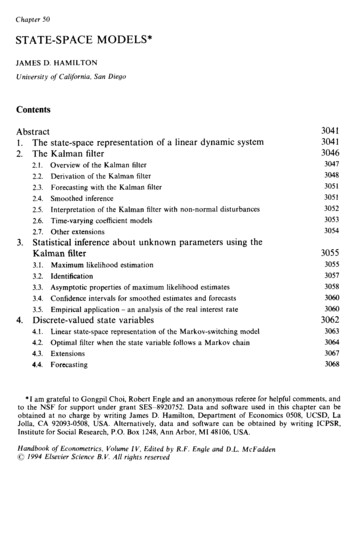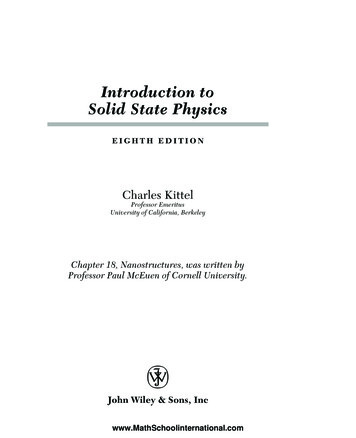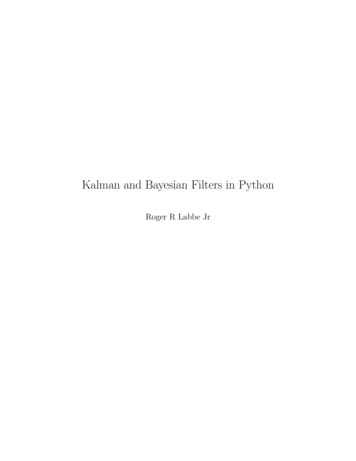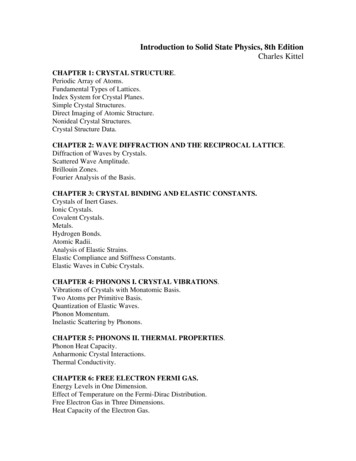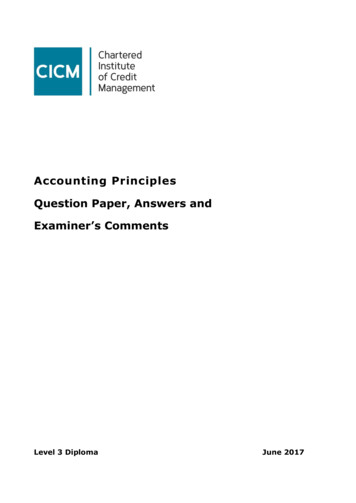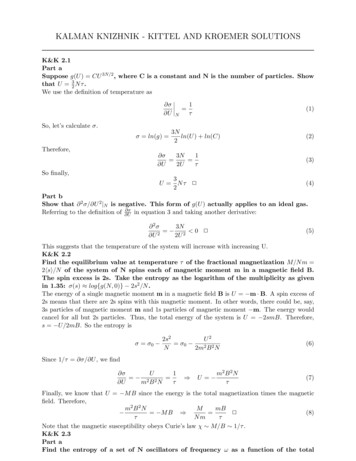
Transcription
KALMAN KNIZHNIK - KITTEL AND KROEMER SOLUTIONSK&K 2.1Part aSuppose g(U ) CU 3N/2 , where C is a constant and N is the number of particles. Showthat U 32 N τ .We use the definition of temperature as σ U N1τ(1)So, let’s calculate σ.σ ln(g) 3Nln(U ) ln(C)2(2)Therefore, σ3N1 U2Uτ(3)3U Nτ 22(4)So finally,Part bShow that 2 σ/ U 2 N is negative. This form of g(U ) actually applies to an ideal gas. σReferring to the definition of Uin equation 3 and taking another derivative: 2σ3N 2 0 2 U 22U(5)This suggests that the temperature of the system will increase with increasing U.K&K 2.2Find the equilibrium value at temperature τ of the fractional magnetization M/N m 2hsi/N of the system of N spins each of magnetic moment m in a magnetic field B.The spin excess is 2s. Take the entropy as the logarithm of the multiplicity as givenin 1.35: σ(s) log{g(N, 0)} 2s2 /N .The energy of a single magnetic moment m in a magnetic field B is U m · B. A spin excess of2s means that there are 2s spins with this magnetic moment. In other words, there could be, say,3s particles of magnetic moment m and 1s particles of magnetic moment m. The energy wouldcancel for all but 2s particles. Thus, the total energy of the system is U 2smB. Therefore,s U/2mB. So the entropy isσ σ0 2s2U2 σ0 N2m2 B 2 N(6)Since 1/τ σ/ U , we find σU1 2 2 Um B Nτ U m2 B 2 Nτ(7)Finally, we know that U M B since the energy is the total magnetization times the magneticfield. Therefore,m2 B 2 NMmB M B 2(8)τNmτNote that the magnetic susceptibility obeys Curie’s law χ M/B 1/τ .K&K 2.3Part aFind the entropy of a set of N oscillators of frequency ω as a function of the total
quantum number n. Use the multiplicity function 1.55 and make the Stirling approximation. Replace N 1 by N .The general expression for the possible ways to obtain the energy nh̄ω amongst a system of Nharmonic oscillators is (equation 1.55):g(N, n) (N n 1)!n!(N 1)!(9)Making the approximation that N is large, we get:g(N, n) (N n)!n!N !(10)from which the entropy σ ln(g) is:σ ln(g) ln{(N n)!} ln(n!) ln(N !)(11)Invoking Stirling’s approximation:σ (N n)ln(N n) N ln(N ) nln(n) 2(12)where I have canceled out some terms.Part bLet U denote the total energy nh̄ω of the oscillators. Express the entropy as σ(U, N ).Show that the total energy at temperature τ isU N h̄ω.exp(h̄ω/τ ) 1(13)This is the Planck result for the energy of a system of N harmonic oscillators.The total energy of the system is U nh̄ω. Thus, we replace n in expression 12 with U/h̄ω:σ (N UUUU)ln(N ) N ln(N ) ln( )h̄ωh̄ωh̄ωh̄ω(14)Now we can do a little rearranging:σ N ln(UN h̄ωN UUUUN h̄ω) ln( U h̄ω ) N ln(1 ) ln(1 )Nh̄ωN h̄ωh̄ωUh̄ω(15)Next, we use the thermodynamic definition of temperature σ/ U 1/τ , to calculate 1/τ :1 σN1N h̄ωU N h̄ω11 ln(1 ) UNh̄ω2 UUh̄ω U 1 Uτ1 N h̄ω N h̄ω h̄ω(16)Cleaning up the expression a bit, we see that the first and last terms in the derivative actuallycancel: σN1N h̄ωN1N h̄ω1 ln(1 ) ln(1 ) (17) UN h̄ω Uh̄ωUU N h̄ωh̄ωUτwhich we can easily solve for U:1 h̄ωN h̄ω exp( )Uτ U N h̄ω2exp( h̄ωτ ) 1(18)K&K 2.4Suppose that 1010 monkeys have been seated at typewriters throughout that age of theUniverse, 1018 seconds. This number of monkeys is about three times greater than the
present human population of the earth. We suppose that a monkey can hit 10 typewriter keys per second. A typewriter may have 44 keys; we accept lowercase letters inplace of capital letters. Assuming that Shakespeare’s Hamlet has 105 characters, willthe monkeys hit upon Hamlet?Part a: Show that the probability that any given sequence of 105 characters typed atrandom will come out in the correct sequence is of the order of 44 100000 10 164345 .There are 44 keys on a typewriter, so the probability that the first letter is correct is 1/44. Theprobability that the second letter is correct is 1/44, etc. Since we need all the letters to be correct,we need to raise 1/44 to the power of the number of letters in Hamlet:1 100000 44 100000 10 log10 (44) 100000 10 164345 244(19)where I have used the fact that log10 (4) 1.64345.Part b: Show that the probability that a monkey-Hamlet will be typed in the age ofthe Universe is approximately 10 164316 .Since a monkey types 10 letters a second, and the age of the Universe is 1018 seconds, the totalnumber of letters that can be typed by one monkey in that time is 1019 . The monkey is able tostart with any of them except for the last 1019 (105 1) 1019 of them. Now, the probabilitythat a sequence of 105 letters will yield Hamlet is given in equation 19. Since there are 1019characters that it can start typing with in order to create Hamlet, the probability that one monkeywill type Hamlet in the age of the Universe isP (Hamlet, 1M onkey) 1019 10 164345(20)so the probability that 1010 monkeys will do it is (just multiplying by 1010 ):P (Hamlet) 1010 1019 10 164345 10 164316 2(21)K&K 2.5Given two systems of N1 N2 1022 spins with multiplicity functions g1 (N1 , s1 ) andg2 (N2 , s s1 ), the product g1 g2 as a function of s1 is relatively sharply peaked at s1 ŝ1 .For s1 ŝ1 1012 , the product g1 g2 is reduced by 10 174 from its peak value. Use theGaussian approximation the multiplicity function.Part aCompute g1 g2 /(g1 g2 )max for s1 ŝ1 1011 and s 0.We use equation 17 in K&K, which describes the number of states in a configuration of deviationδ from equilibrium:g1 (N1 , ŝ1 δ)g2 (N2 , ŝ2 δ) (g1 g2 )max exp( 2δ 2 2δ 2 )N1N2(22)with δ 1011 and N 1022 , we getg1 g22 (1011 )2 2 (1011 )2 exp( ) 0.0183 2(g1 g2 )max10221022(23)If the deviation δ is even an order of magnitude different, the multiplicity is incredibly different.0.0183 corresponds to a deviation of 1011 from equilibrium, while for a deviation of 1012 the resultwould be 10 174 . Plotting equation 22 on a log-log plot with N1 N2 1022 reveals basically aline that drops almost precisely at δ 1011 .K&K 3.1Part aFind an expression for the free energy as a function of τ of a system with two states,one at energy 0 and one at energy .The partition function is:Z exp( 0/τ ) exp( /τ ) 1 exp( /τ )(24)
and the free energy is related to the partition function by F τ ln(Z), so:F τ ln(Z) τ ln(1 exp( /τ )) 2(25)Part bFrom the free energy, find expressions for the energy and entropy of the system.The energy is calculated from the derivative of the partition function, but I am just going to writethe normalized energy explicitly:U 0 exp( 0/τ ) exp( /τ )exp( /τ ) 2exp( 0/τ ) exp( /τ )1 exp( /τ )(26)and the entropy can be calculated by σ F/ τ at constant volume:σ exp( /τ ) τ ln(1 exp( /τ )) ln(1 exp( /τ )) ( ) 2 τ1 exp( /τ ) τ(27)As a sanity check, note that U τ σ reproduces F . Furthermore, note that σ 0 as τ 0,consistent with the third law of thermodynamics. As τ , σ ln(2).K&K 3.2Part aUse the partition function to find an exact expression for the magnetization M and thesusceptibility χ dM/dB as a function of temperature and magnetic field for the modelsystem of magnetic moments in a magnetic field. The result for the magnetization isM nmtanh(mB/τ ), where n is the particle concentration.The energy of a single magnetic moment is m·B, depending on the orientation of the moment.Therefore the partition function is:Z exp( mB/τ ) exp(mB/τ ) 2cosh(mB/τ )(28)and the average magnetic moment at temperature τ ism exp( mB/τ ) m exp(mB/τ ) mtanh(mB/τ )exp( mB/τ ) exp(mB/τ )hmi (29)So to find the total magnetization, we need to multiply by the particle concentration n:M mntanh(mB/τ ) 2(30)dMnm2 sech2 (mB/τ ) 2dBτ(31)Thereofre, the susceptibility isχ Part bFind the free energy and express the result as a function only of τ and the parameterx M/nm.The free energy isF τ ln(Z) τ ln(2cosh(mB/τ ))(32)22Top get this in the desired form, we used the trig identity sech x 1 tanh x, so coshx 1/1 tanh2 x. Therefore, the free energy can be written as:sF τ ln(21ττ41 x2) ln() ln() 2M21 tanh (mB/τ )2241 ( nm )2Part cShow that the susceptibility is χ nm2 /τ in the limit mB τ .(33)
This follows directly from equation 31 and the fact that sech2 x 1 for x 1. 2K&K 3.3Part aA one dimensional harmonic oscillator has an infinite series of equally spaced energystates, with s sh̄ω, where s is a positive integer or zero, and ω is the classicalfrequency of the oscillator. We have chased the zero of energy at the state s 0.Show that for a harmonic oscillator, the free energy isF τ ln(1 exp( h̄ω/τ ))(34)Note that at high temperatures such that τ h̄ω we may expand the argument of thelogarithm to obtain F ln(h̄ω/τ ).The partition function for this system is:Z Xexp( sh̄ω/τ ) s 011 exp( h̄ωτ )(35)The free energy is related to the partition function by F τ ln(Z), so:F τ ln{1} τ ln{1 exp( h̄ω/τ )} 21 exp( h̄ωτ )(36)Part bFrom equation 34 show that the entropy isσ h̄ω/τ ln(1 exp( h̄ω/τ ))exp(h̄ω/τ ) 1(37)The entropy is related to the free energy by σ F/ τ . Thus:σ h̄ω/ττ ln{1 exp( h̄ω/τ )} ln{1 exp( h̄ω/τ )} 2 τexp(h̄ω/τ ) 1(38)K&K 3.4Consider a system of fixed volume in thermal contact with a reservoir. Show that themean square fluctuation in the energy of the system ish( h i)2 i τ 2 U τ(39)VHere U is the conventional symbol for h i. Hint: Use the partition function Z to relate U/ τ to the mean square fluctuation. Also, multiply out the term (.)2 . Note: Thetemperature τ of a system is a quantity that by definition does not fluctuate in valuewhen the system is in thermal contact with a reservoir. Any other attitude wouldbe inconsistent with our definition of the temperature of a system. The energy ofsuch a system may fluctuate, but the temperature does not. Some workers do notadhere to a rigorous definition of temperature. Thus Landau and Lifshitz give theresult h( τ )2 i τ 2 /CV , but this should be viewed as just another form of equation 39,with τ set equal to U/CV . We know that U CV τ , whence the Landau-Lifshitzresult becomes h( U )2 i τ 2 CV which is our result (equation 39).We first use the fact thath( h i)2 i h 2 i h i2(40)Next, we recall the definition of the average energy: U h i ( 1/Z) Z/ β V . where β 1/τ .Similarly, h 2 i (1/Z) 2 Z/ β 2 V . Therefore:h 2 i h i2 1 2Z1 Z 2 1 Z U 2() () 2Z βZ β β Z β β(41)
where everything is understood to be at constant volume. Since β 1/τ, dβ dτ /τ 2 , meaningthat: U U τ22(42)h 2 i h i2 β V τ VK&K 3.5Overhauser Effect. Suppose that by a suitable external mechanical or electrical arrangement one can add α to the energy of the heat reservoir whenever the reservoir passesto the system the quantum of energy . The net increase of energy of the reservoir is(α 1) . Here α is some numerical factor, positive or negative. Show that the effectiveBoltzmann factor for this abnormal system is given byP ( ) exp( (1 α) /τ ).(43)This reasoning gives the statistical basis of the Overhauser effect whereby the nuclearpolarization in a magnetic field can be enhanced above the thermal equilibrium polarization. Such a condition requires the active supply of energy to the system froman external source. The system is not in equilibrium, but said to be in a steady state.Let U0 be the energy of the reservoir when the system has 0 energy. Then, when the reservoir gives energy to the system, it gains energy α , so that its energy after this transfer isU0 α U0 (1 α) . Now, the probability to find the system in a state with energy sys is proportional to the number of states of the system with that energy, and therefore is also proportional tothe number of states of the reservoir with energy U0 (1 α) sys , i.e. P ( sys ) gR (U0 (1 α) sys ).Following the book, we can write:P ( ) gR (U0 (1 α) sys ) exp{ln[gR (U0 (1 α) sys )]} exp{σR (U0 (1 α) sys )} (44)where I have used the definition of entropy σ ln(g). Now if we expand the entropy in a Taylorseries, we have:σR (U0 (1 α) sys )} σR (U0 ) (1 α) sys σ σR (U0 ) (1 α) sys /τ U(45)where I have used the thermodynamic definition of temperature in the last equality. Inserting thisinto equation 44, we get:P ( ) exp(σR (U0 ) (1 α) sys /τ ) exp( (1 α) sys /τ ) 2(46)K&K 3.6In our first look at the ideal gas we considered only the translational energy of theparticles. But molecules can rotate with kinetic energy. The rotational motion isquantized; and the energy levels of a diatomic molecule are of the form (j) j(j 1) 0 ,where j is an positive integer including zero. The multiplicity of each rotational levelis g(j) 2j 1.Part aFind the partition function ZR (τ ) for the rotational states of one molecule. Rememberthat Z is a sum over all states, not over all levels - this makes a difference.The partition function will have the formZR (τ ) X(2j 1)exp( j(j 1) 0 /τ ) 2(47)jPThe sum over the states s exp( s /τ ) has been converted to a sum over the energy levels j viathe degeneracy of the states 2j 1. For each j, there are 2j 1 states that share the same energy,so we must multiply by this factor to convert the sum over states into a sum over energy levels.Part b
Evaluate ZR (τ ) approximately for τ 0 , by converting the sum to an integral.We get, after converting the sum to an integral,Z ZR (τ ) 12dj(2j 1)exp( j(j 1) 0 /τ )(48)The lower limit on the integral is 1/2 since the function looks like a Gaussian, with zeroes atinfinity and j 1/2. Next, let u j(j 1). Then (2j 1)dj du, and our integral isZ ZR (τ ) 14duexp( u 0 /τ ) τexp( u 0 /τ ) 0 14 τexp( 0 /4τ ) 0(49)When τ 0 , the exponential dominates, we can expand the exponential to get:ZR (τ ) τ 01τ(1 O(τ 1 ) . 2 .) 04τ 0 4(50)Part cDo the same for τ 0 , by truncating the sum after t
KALMAN KNIZHNIK - KITTEL AND KROEMER SOLUTIONS K&K 2.1 Part a Suppose g(U) CU3N 2, where C is a constant and N is the number of particles. Show that U 3 2 N . We use the de nition of temperature as @ @U N 1 (1) So, let’s calculate . ln(g) 3N 2 ln(U) ln(C) (2) Therefore, @ @U 3N 2U 1 (3) So nally, U 3 2 N 2 (4) Part b Show that @2 @U2j N is negative. This .
